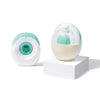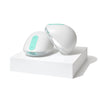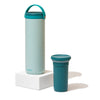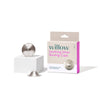Clogged milk ducts, also known as “plugged” ducts, are a condition that many breastfeeding moms deal with during the early postpartum period. While they’re usually easy to relieve, they can still cause pain and discomfort, impact milk production, and turn into something more serious (like mastitis) if left untreated.
In this article, we’ll dive deeper into clogged ducts to cover:
- What a clogged duct is
- Common causes of clogged ducts
- How to identify a clogged duct
- How to treat a clogged duct
- When to seek professional help
What is a Clogged Milk Duct?
A milk duct is a small tube that carries milk from your breast tissue to your nipple. It can become plugged when milk flow is blocked, and the tube fails to drain through the nipple properly.
While a duct can get clogged at any point during your pumping or breastfeeding journey, it’s most likely to happen during the first six to eight weeks postpartum. This is because you’re still establishing your supply and getting into a feeding routine with your baby!
A plugged duct typically develops gradually over the course of a few days or a week and usually in one breast instead of both at the same time. The size and severity of these plugs can vary.
There are a number of reasons that a duct may become clogged:
- Struggling to manage oversupply
- Infrequent feedings, skipping feedings, or going too long in-between feedings causing milk to build up in your breasts
- A baby who is struggling to latch or has a lip or tongue tie (this means that they are probably not draining your breast completely)
- Always feeding in the same position, nursing on the same side last, or sleeping on the same side so that your breast is compressed
- Wearing a shirt or bra that’s too tight (underwire bras can also be a culprit)
Identifying the Symptoms of a Clogged Milk Duct
Look out for a tiny lump — this is the swelling around your milk duct that slows the flow of milk. The lumps are usually the size of a pea (or a bit bigger), firm and lumpy, and painful or sore to the touch. They might also be red in color.
Physical Signs of a Clogged Duct
A clogged duct will likely present itself as pain while pumping, tenderness, and/or swelling in your breast. You may also feel a firm lump or “knot” — moms often describe it as a bead, marble, or nodule. The area may feel warm (or even hot) to the touch, and your milk may look thick or stringy. This is because it’s not able to flow freely through your nipple.
You may also experience a dip in milk output when dealing with a plug. The good news is that as long as you’re proactive about treatment, it will only be temporary. (This is why it’s so important to keep feeding when dealing with this kind of condition. More on that later!)
Visual Signs of a Clogged Milk Duct
The area surrounding the duct may be swollen and darker than usual — some moms even notice a red or pink color. This is a symptom of inflammation, which happens when your breast swells from producing milk that can’t be properly drained.
Sometimes, moms confuse small white dots on their nipples for plugged ducts. But these are actually different — they’re called “milk blebs,” and they occur when milk gets trapped under some skin of the nipple in a nipple pore. Like plugged ducts, they can also be super uncomfortable, but their treatment is different.
Describing the Pain
Plugged ducts can feel like a sharp or shooting pain before or during breastfeeding. Sometimes, the pain is milder — due to pressure building up behind the plugged duct, you might just feel what many moms describe as an aching or soreness.
Comparing to Other ConditionsPlugged ducts can turn into mastitis — an inflammation of the breast caused by obstruction or infection — if they’re not treated appropriately. Compared to plugged ducts, mastitis usually comes on more abruptly and can cause symptoms that are more painful and severe. It may even need to be treated with antibiotics, which your OBGYN will need to prescribe.
While plugged ducts and mastitis share some physical and visual symptoms (breast swelling, breast redness, temporary dip in supply), mastitis will usually often present itself with the following:
- A fever of 101.3° or higher
- Flu-like symptoms like aching or exhaustion
- Broken skin on the nipple (this indicates you’re dealing with an infection)
- Red streaks on the breast
- Blood, mucus, or blood in milk
- Milk tastes salty (due to higher sodium content)
How to Treat a Clogged Milk Duct
First things first: keep it cold! Applying heat to your breasts will likely make your symptoms worse — you’ll want to use an ice pack every 30 minutes or so, leaving the ice on for about 10 minutes at a time. (If you’re wondering what happened to the guidance about applying heat, you’re not alone. The Academy of Breastfeeding Medicine recently changed their guidance for treating plugged ducts and mastitis. Now, moms are encouraged to avoid warm compresses — as well as deep massage, which was another recommendation — and to stick to cold compresses. Read more from ParentData author Emily Oster here.)
Additionally, make sure that you’re continuing to pump or feed.
- Try to stick to the same routine you’ve been following and feed every 2-3 hours or however often your baby needs to eat.
- If you’re nursing, make sure to start with a different breast each time so that both sides are adequately emptied over the course of the day
- Don’t overfeed on the affected side or over-massage to try and “break up” the plug — that could end up making things worse.
Here’s what else to focus on:
Proper Breastfeeding Positions
Choose breastfeeding positions that give you a better chance at fully draining your breasts and emptying the plugged ducts.
- Football hold: Also known as the rugby hold, this involves holding your baby like a football along your forearm, with their body on your arm and face towards your breast. In this position, your baby can reach (and empty) your bottom ducts. This happens to be a great position for sore nipples as well!
- Dangle feeding: This involves leaning over your baby (or crouching on all fours) and dangling your breast into their mouth, allowing gravity to help empty your plugged duct.
Hydration and Nutrition
Whether you’re dealing with plugged ducts or not, staying hydrated and consuming enough calories and nutrient-rich foods will help improve your milk flow and maintain a healthy supply. Dehydration, especially during hot weather, can increase the risk of developing a plugged duct in the first place, so you’ll want to make sure you’re drinking enough water!
Wearing Comfortable Clothing
Avoid wearing clothing that’s too tight, both to prevent clogged ducts from happening in the first place and to relieve them once you notice symptoms of a plug. Make sure that you have a wireless nursing or pumping bra that’s snug without being too tight, and try not to sleep on your stomach if you can help it. Anything that compresses your breasts — even a baby carrier that’s too snug — can increase the risk of restricting milk flow and make it harder to treat once you’re dealing with it.
Maintaining Good Breast Hygiene
There are many ways to take care of your breasts and prevent issues like plugged ducts and mastitis from occurring. Even before you notice swelling or inflammation, you can use our Hot & Cold Breast Therapy Pack. When warm, it can help encourage letdown (and adequate milk flow) before a pumping or feeding session, and when frozen, it can help to relieve minor swelling and prevent inflammation from occurring.
You’ll also want to try and keep your nipples clean and free of cracks or irritation since broken skin is more likely to become infected and could lead to mastitis. You can use our Soothing Silver Nursing Cups or Cooling Gel Nipple Pads to relieve sore, irritated nipples and free them from blisters and cracks.
When to Seek Professional Help
If you’re dealing with plugged ducts or worried that you may be developing mastitis, reach out to your OBGYN, lactation consultant, or healthcare provider to discuss a course of action. Getting ahead of these conditions before they throw your feeding plans off track — and have the chance to derail your production — is so important!
(Not sure how to connect with an LC? Start by asking your pediatrician or OBGYN for a local recommendation, or explore care through a platform like SimpliFed, which offers virtual support.)
If you’ve developed a fever, flu-like symptoms, or any of the mastitis symptoms listed above, you can talk to a professional about antibiotics.
Overcoming Clogged Milk Ducts
The takeaway: While clogged milk ducts are common in early postpartum days, they need to be addressed so they don’t become more serious (mastitis) and cause a dip in milk production. Taking proactive care of your breasts is so important, and there are products and tools to help!
You can shop more products for breast care and comfort in our Find Your Flow Feeding Kit, where you’ll find Hot & Cold Breast Therapy Packs, Cooling Gel Nipple Pads, Soothing Silver Nursing Cups, and more breastfeeding essentials for the early postpartum days and beyond.
Clogged Milk Duct FAQs
- What are the symptoms of a clogged milk duct?
- A clogged milk duct typically presents as a small, firm lump in the breast that is painful or sore to the touch, often accompanied by swelling, redness, and sometimes warmth. The affected area may also feel tender, and you might notice a decrease in milk output from the affected breast.
- How can I treat a clogged milk duct?
- To treat a clogged milk duct, apply cold compresses to the affected area every 30 minutes for about 10 minutes at a time and continue to breastfeed or pump regularly to keep milk flowing. Additionally, using different breastfeeding positions, staying hydrated, wearing comfortable clothing, and maintaining good breast hygiene can help relieve the blockage.
- When should I seek professional help for a clogged milk duct?
- Seek professional help for a clogged milk duct if you develop a fever, flu-like symptoms, or any signs of mastitis, such as red streaks on the breast, broken skin, or if the condition does not improve with home treatment. Consult your OBGYN, lactation consultant, or healthcare provider to discuss appropriate
Tags Used





